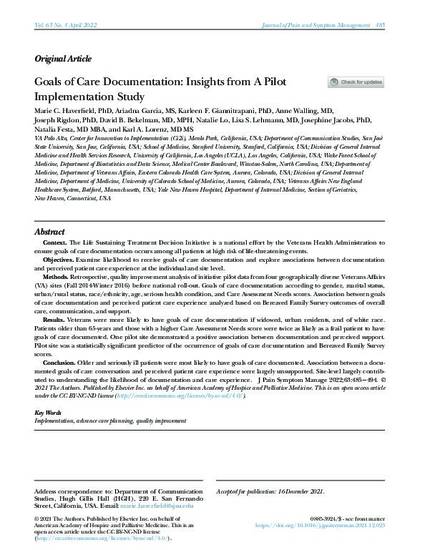
Context
The Life Sustaining Treatment Decision Initiative is a national effort by the Veterans Health Administration to ensure goals of care documentation occurs among all patients at high risk of life-threatening events.
Objectives
Examine likelihood to receive goals of care documentation and explore associations between documentation and perceived patient care experience at the individual and site level.
Methods
Retrospective, quality improvement analysis of initiative pilot data from four geographically diverse Veterans Affairs (VA) sites (Fall 2014-Winter 2016) before national roll-out. Goals of care documentation according to gender, marital status, urban/rural status, race/ethnicity, age, serious health condition, and Care Assessment Needs scores. Association between goals of care documentation and perceived patient care experience analyzed based on Bereaved Family Survey outcomes of overall care, communication, and support.
Results
Veterans were more likely to have goals of care documentation if widowed, urban residents, and of white race. Patients older than 65-years and those with a higher Care Assessment Needs score were twice as likely as a frail patient to have goals of care documented. One pilot site demonstrated a positive association between documentation and perceived support. Pilot site was a statistically significant predictor of the occurrence of goals of care documentation and Bereaved Family Survey scores.
Conclusion
Older and seriously ill patients were most likely to have goals of care documented. Association between a documented goals of care conversation and perceived patient care experience were largely unsupported. Site-level largely contributed to understanding the likelihood of documentation and care experience.
- Implementation,
- advance care planning,
- quality improvement
Available at: http://works.bepress.com/marie-haverfield/61/

This is the Version of Record and can also be read online here.